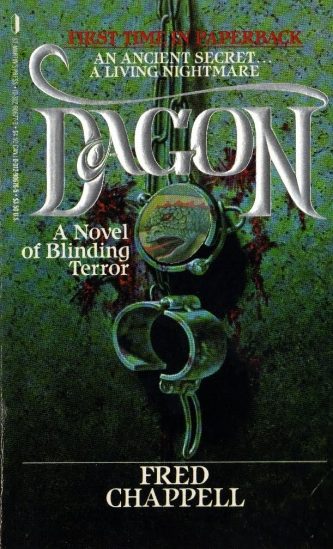 By FRED CHAPPELL (St. Martin’s; 1968/1987)
By FRED CHAPPELL (St. Martin’s; 1968/1987)
Among my absolute favorite horror novels Fred Chappell’s DAGON looms large. I first grabbed it off the paperback racks of a Sav-On back in 1987—I was about fourteen at the time, and expecting, based on the lurid cover artwork of the St. Martin’s reprint (apparently the book’s “First Time in Paperback” since its initial 1968 publication), something trashy and gory. What I got instead was a beautifully written, profoundly disturbing evocation of madness, obsession and transformation unlike anything else I’d read before (or since).
Now, over twenty years later, I’ve experienced DAGON for the fourth or fifth time, and found it every bit as affecting as it was the first. A large part of its power lies in the sheer strangeness of the novel, a deeply mysterious and often downright puzzling account that imparts a real sense of ancient, unknowable evil in singularly poetic and surreal fashion. It’s similar in that regard to Arthur Machen’s classic tale “The White People,” which like DAGON succeeds in conveying a fully realized world of supernatural mystery while explaining very little.
DAGON is the story of Peter Leland, a young preacher who together with his wife Sheila is visiting his parents’ North Carolina farm, which he’s just inherited. His childhood was marked by the suspicious death of his father, about which he knows very little. Peter feels a strange sort of calling during his stay at the farm, experiencing disturbing memories and hallucinations that involve words like “Cthulhu” and “Yog Sothoth.” Peter’s aim while at the farm is to study and write about Dagon, an ancient pagan god described in the bible as having had his head and palms cut off. What Peter should be studying is the H.P. Lovecraft story of that name, which will prove far more relevant to his situation.
While investigating the attic of his family’s residence Peter discovers a pair of bloodstained shackles to which he inadvertently chains himself for the space of a day, which triggers a buried childhood memory of his father in the same predicament. The experience so impacts Peter that he loses his mind and suddenly and shockingly murders his wife.
From there the narrative enters its own inscrutable realm. The neighboring Mina, a young woman whose strangely fish-like features attract Peter, assumes control of the story. She takes over Peter’s life by plying him with moonshine that renders him impotent and generally treating him like a dog. Together with her boyfriend Coke Rymer, Mina commandeer Peter’s car and takes him on a road trip to an old house, where Peter has his entire body tattooed in preparation for a final meeting with the object of his now-abandoned studies.
This definitely isn’t your average scary book. Author Fred Chappell plays by his own rules, creating a sensuous yet decaying world unique to itself. Chappell, a longtime resident of North Carolina, has a real feel for the Deep South, which in DAGON becomes a landscape of terror every bit as vivid and distinct as those of Machen or Lovecraft.
This book is apparently something of an anomaly in Chappell’s cannon, which consists mostly of uplifting novels like BRIGHTEN THE CORNER WHERE YOU ARE and I AM ONE OF YOU FOREVER (not to mention the anthology MORE SHAPES THAN ONE, containing several horror and fantasy themed stories). Nonetheless, the sense of terror and despair evoked by DAGON are undeniable. It is, as far as I’m concerned, essential reading for all devotees of genre fiction, and one of the few classics of the form.
